Coronal Topology and Coronal Mass Ejections
Alan H. McAllister
Helio Research
Collaborators: A. Hundhausen and D. MacKay
Cartoons and Animations by T. McAllister
We present here work carried out over the last decade focused on understanding the large scale coronal evolution and signatures associated with coronal mass ejection (CME) generation. In particular we present a (1) summary of the use of x-ray arcades as CME proxies, (2) the resultant discovery of certain "active locations" for CMEs in the declining phase of the solar cycle, and (3) the suggestion that besides the 2D photospheric shearing due to differential rotation we should consider 3D shearing due to different rotational dynamics for the photosphere and the corona.
Coronal Streamers, Coronal Arcades and CMEs
The Solar Maximum Mission (SMM) observations [Hundhausen, 1993] suggested that there was an association between the white light streamers which are the main source of CMEs (as seen in coronagraphs) and the dynamic coronal arcades seen in x-rays following at least some CMEs. The x-ray observations from Yohkoh have cemented this association by allowing a large scale statistical study.
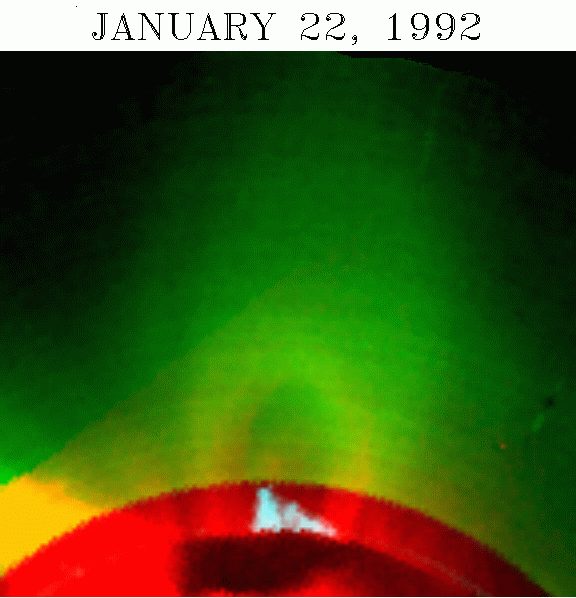
|
| Figure 1. A composite of three images illustrating the relationship of a white light streamers (green), an underlying coronal soft x-ray arcade (yellow), and below that a large Ha filament (blue/red). All seen in profile over the solar limb. |
After Yohkoh's Soft X-ray Telescope (SXT) started returning images in September 1992, it became apparent that most quiet sun CMEs had an associated dynamic soft x-ray arcade appearing after the eruption [McAllister et. al., 1992; Hanaoka et. al., 1994; Hiei, Hundhausen, and Sime, 1993; McAllister et. al., 1996]. When bright enough these correspond to the well know long duration event (LDE) class of x-ray flares [Sheeley et. al., 1975]. As the solar cycle declines the complexity of the lower solar corona due to large active regions reduces and these quiet sun LDEs come to be the main component of CME signature events. Using the Yohkoh movie McAllister and Hundhausen [1996] surveyed 18 months (January 1993 to June 1994) of dynamic arcade signatures.
The locations of these arcades were compared to the locations of white light coronal streamers observed by the High Altitude Observatory's (HAO) Mauna Loa white light coronagraph.
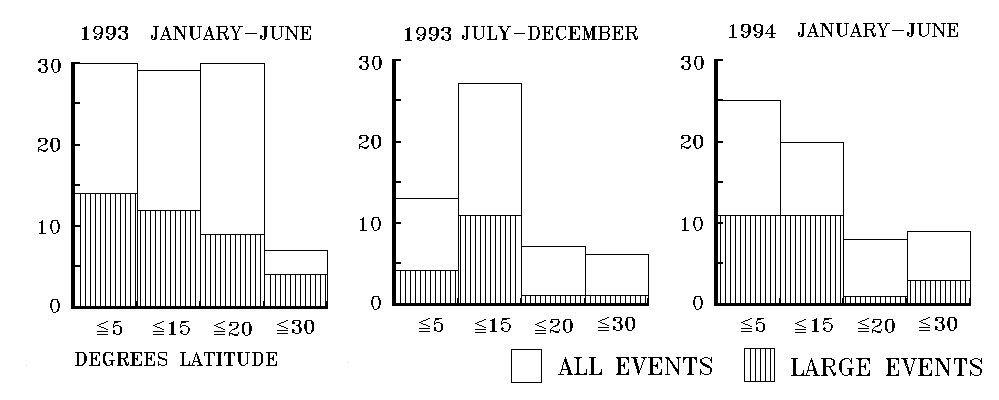
|
|
|
As this figure illustrates there is good correlation of the arcades with the streamers, especially the large arcades (those having a footprint dimension larger than 20 degrees). The fluctuation in the statistics for these 3 six month periods is related to the complexity of the solar corona. For the last six months, when the corona had simplified the statistics are cleanest.
Based on this survey of 244 events, 73% of the arcades had centers within 20o of the nearest streamer; 83% for large arcades. This is consistent with the SMM synoptic results (bugles) [Hundhausen,1993]. The average monthly event rate, 10-20 per month, is roughly consistant with previous estimates [Webb & Howard, 1994] for CME occurance in the declining phase of the solar cycle, indicating that we are "seeing" most CMEs with the arcade signature.
We concluded that it is resonable to use the SXT arcades as a CME proxy signature.Coronal Arcades, CMEs, and Switchbacks
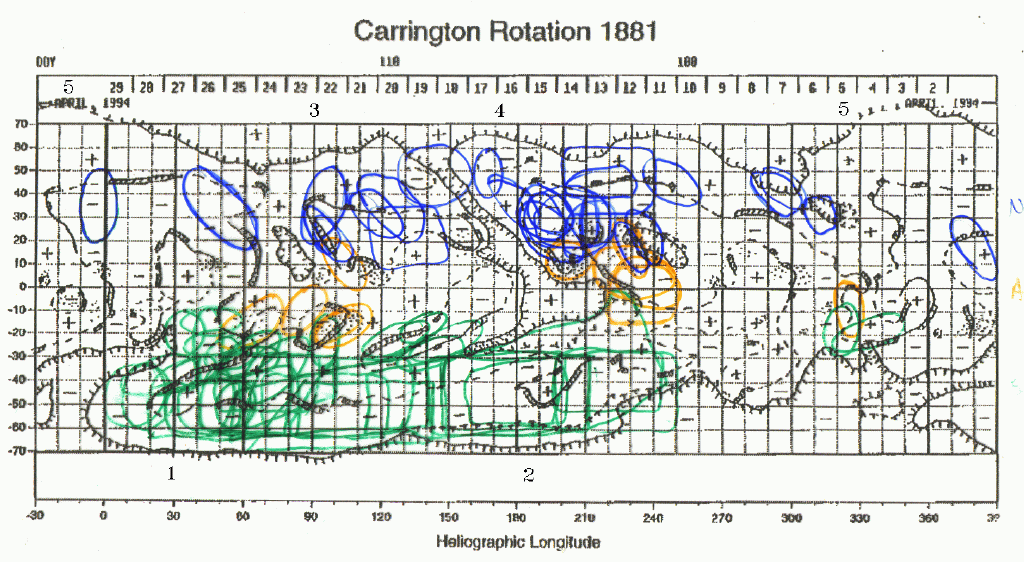
|
| Figure 3. The last six months of the study period, January through June 1994, on the McIntosh Ha synoptic map [McIntosh, 1979] for Carrington rotation 1881. Each outline represents an SXT arcade signature. The colors distinquish southern hemisphere(green), active latitude(orange), and northern hemisphere(blue) events. |
When plotted this way we find that CME occurance is not random nor uniformly distributed. They are found to occur mainly in certain prefered "active locations". In this six month period there are in fact three(3) main active locations, or clusters of CMEs. There is a fourth smaller cluster as well.
Two of the main locations lie to the west of a polar coronal hole extension, one in the southern hemisphere and one in the north. The secondary cluster lies to the west of a small isolated coronal hole, which is the end of a pinched off northern polar coronal hole extension, and thus has a similar dynamic. These locations have been called switchbacks, as there is a neutral line that starts as a part of the polar crown and connects to a mid-latitude diagonal neutral line along the polar crown extension (e.g. see figures below). This configuration is the subject of the discussion of 3D shearing that follows below.
In the study 42% of mid- and high-latitude coronal arcades were along switchbacks. This percentage increases from 37% in the first half of 1993 to 50% in the first half of 1994.A program of simulations carried out by van Ballegooijen, Cartledge, and Priest [1998], van Ballegooijen, Priest, and MacKay [2000], MacKay, Gaizauskas, and van Ballegooijen [2000], MacKay and van Ballegooijen [2001] has shown that the switchbacks are formed and fed by the poleward diffusion of aging active regions. So the long lived switchbacks are related to active region clusters. See also McAllister, MacKay, and Martin [2002].
The last location lies along the long southern polar crown directly south of a large trans-equitorial extension of the north polar coronal hole. This was the site of the third main concetration of events. The dynamic for this location was most likely a shearing parallel to the inversion line between between the two coronal holes, and is thus not directly related to the discussion of vertical shearing presented below.
Coronal Hole Association.
That CMEs are somehow associated with coronal holes has been suggested by various authors [Hewish and Bravo, 1985; Bravo, 1995; Bhatnager, 1996]. To some extent this is a matter of scale, i.e. many CMEs cover a large enough area that it would be hard to place them on the sun and keep them far from all coronal holes. However, it is still a relevant observation, which is supported by our survey.
In our study we recorded the direction to any coronal holes topologically next to an arcade. In general this means they are within 20o of the arcade, but the key criterion is that there are no intervening neutral lines. The major exceptions to a strict 20o limit were for events west of a coronal hole. The scales at high latitudes are such that arcades may be up to 60o away and still be topologically close.
Of the 244 events 80% were within 20o of a coronal hole.We must recall that our sample contains only large events, and few of the more compact active region signatures. These events by definition are of lower latitude and more likely to be farther from a coronal hole. However, the association for larger mid and high latitude signatures is significant.
In our discussion of coronal evolution in the next section we will find that the presence of a coronal hole, especially to the west of a neutral line is part of a dynamic that tends to generate CMEs.
Coronal Evolution and 3D Differential Rotation
We are used to thinking about the different latitudinal rotation profiles for the photospheric magnetic fields, in which the in the equitorial fields rotate around the solar axis faster than the polar fields [Antonucci & Svalguard, 1974]. On the other hand the solar corona shows little differential, tending to rotate rigidly at a rate close to the equitorial rate, but considerably different from the higher latitude photosphere [Antonucci & Svalguard, 1974]. Recently Tomzack and Hassler [1995?] have confirmed this from solar sizemology measurements, extending it to show variations with the solar cycle.
What concerns us here is the idea that the mid and higher lattitude corona (rotating relatively rigidly) and photospheric (with its own latitudinal profile) magnetic fields tend to rotate at significantly different rates.
This suggest that as well as the usual considerations of latitudinal differential rotation stressing magnetic field configurations, there may be vertical (3D) stresses caused by the coronal and photospheric rotation differences.
The first question is how can these two levels move with significantly different rates, as they appear to do. We would like to suggest that the answer can be found in the TRACE images of the chromospheric "magnetic carpet" [ref]. The first piece lies in the constant small scale emergance of magnetic fields over the quiet sun [ref]. The second comes from Shibata's study of the jets that arise when small new unipolar sunspots emerge in opposite field quiet sun forming "anemonea" circluar arcade formations[Shibata et al., 1992]. The upper coronal fields, open or closed are not disturbed, but the rising flux reconnects with the existing coronal fields, so that they connect to different chromospheric and photospheric lines.
The proposal here is that there is in fact a constant small scale bubbling of new flux, which connects and reconnects to the overlying coronal structures. This allows the coronal fields to "slide" over the underlying chromospheric carpet without any significant change in the overall pattern.
Coronal Hole Boundaries
We illustrate below the slipping of the corona for a coronal whole boundary; a change from open to closed coronal fields, sliding over the magnetic carpet.
This allows coronal holes and their associated solar wind sector structure to rotate qusi-rigidly.
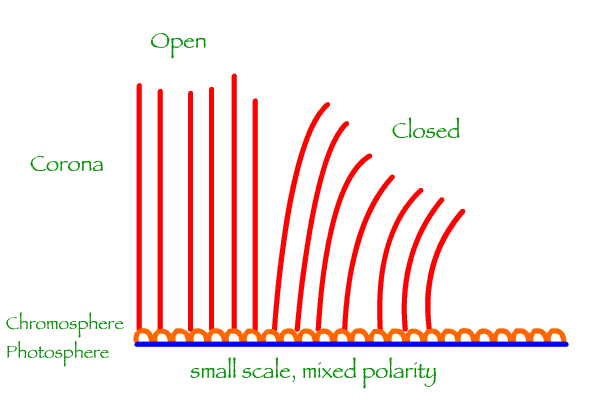
|
|
|
Coronal Arcades over Polarity Inversions
A standard filament formation scenario involves convergent flows moving towards a polarity inversion. We notice here that the convergence of the photosphere, does not require the overlying arcade to change. However cancellation at the neutral line will supply axial field and perhaps filament mass, contributing to filament channel and Ha filament formation. When there is convergence at the coronal level as well the formation of closed field loops would be enhanced.
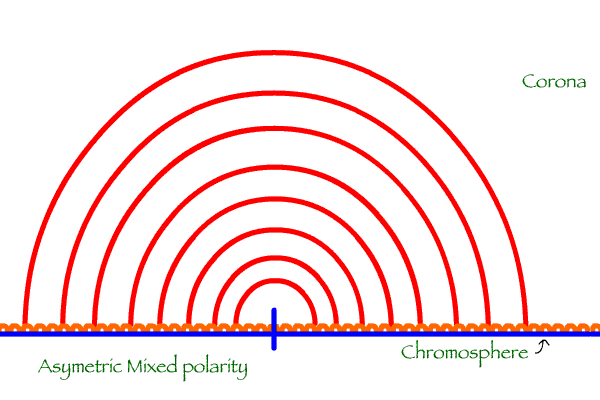
|
|
|
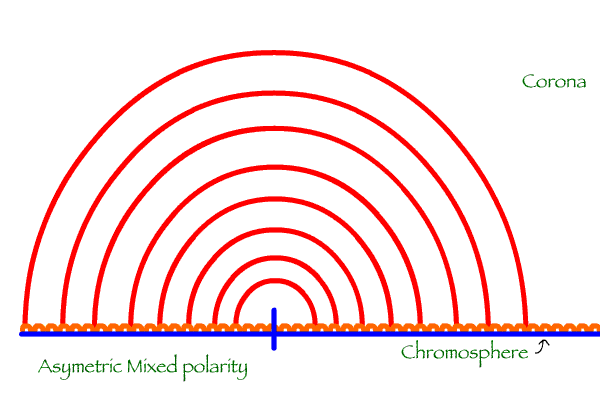
|
|
|
Notice that with the photosphere moving under a coronal arcade with a central neutral line, we have a configuration in which the photospheric motions DO affect the corona. This is because of the change in sign of the excess photospheric polarity as we cross the neutral line. Thus the down stream coronal field lines tend to stay on the down stream side of the neutral line, bunching up, while the upstream side spreads out.
Over all there will be a tendancy for the moving photospheric configuration to drag the coronal arcade with it.However, the coronal preference for rigid motion results in an assymetry of the overlying arcade, with the eastern(downstream) side being tighter and tilting westwards with altitude. Conversely the western(upstream) side is spread out and rises more nearly vertically. The next figure shows a possible application to the known assymetry of the sides of narrow trans-equitorial coronal hole boundaries.
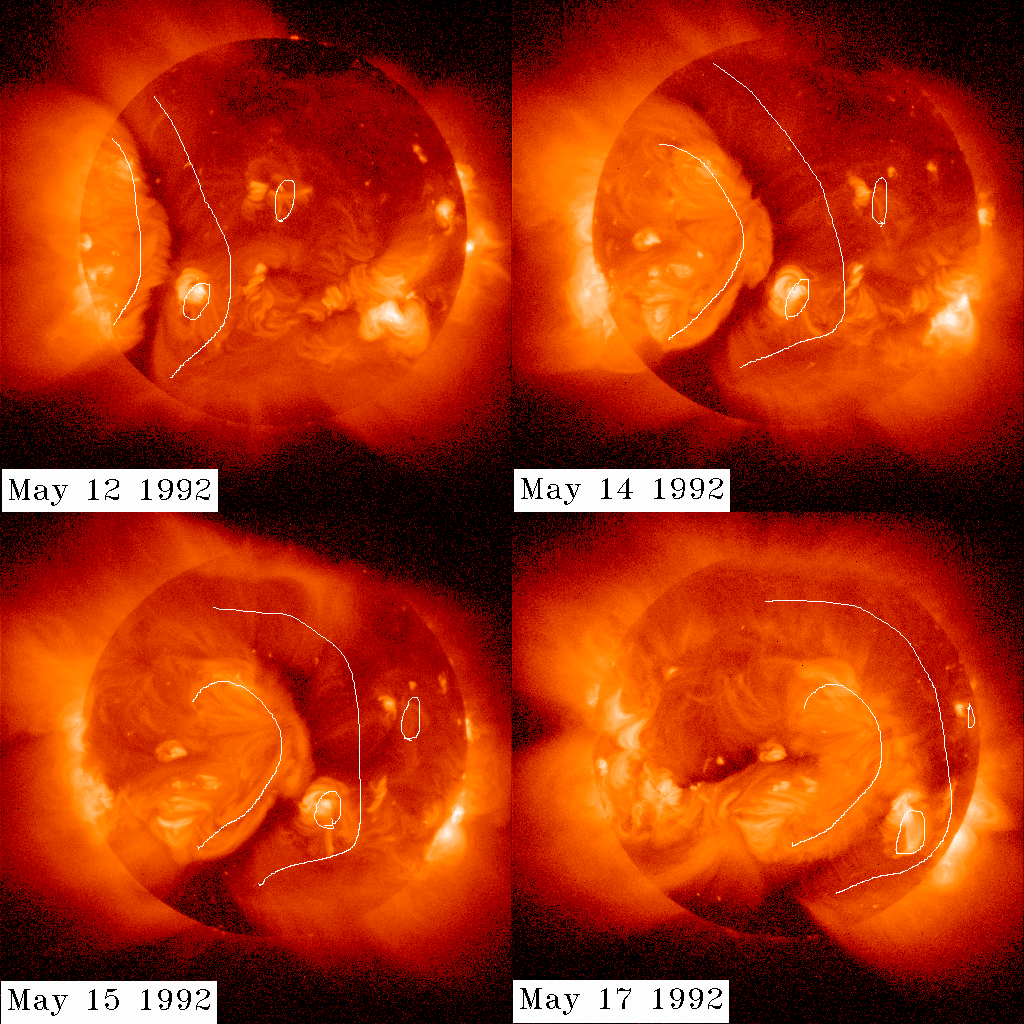
|
| Figure 4. The disk passage of a long trans-equitorial coronal hole in May 1992. Note the poor visiblity towards the western limb. The white dashed lines indicate underlying polarity inversion lines. |
Switchbacks and Coronal Holes
In the switchback formations that we have discribed above, there is a combination of a coronal arcade moving eastward into a coronal hole extension which is relatively rigid.
We suggest that the result is a vertical shearing of the coronal fields, as the arcade is dragged under the edge of the open coronal hole fields, enhancing the production of CMEs.
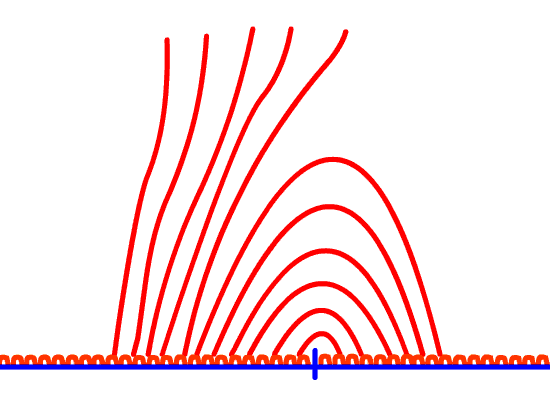
|
|
|
[Click here for a CME animation]
Working with the white light coronagraph data used in the streamer survey above we have reconstructed the vertical profile of the polarity inversion (streamer center) over a switchback from February 21, 1993. The location and x-ray images are shown below.
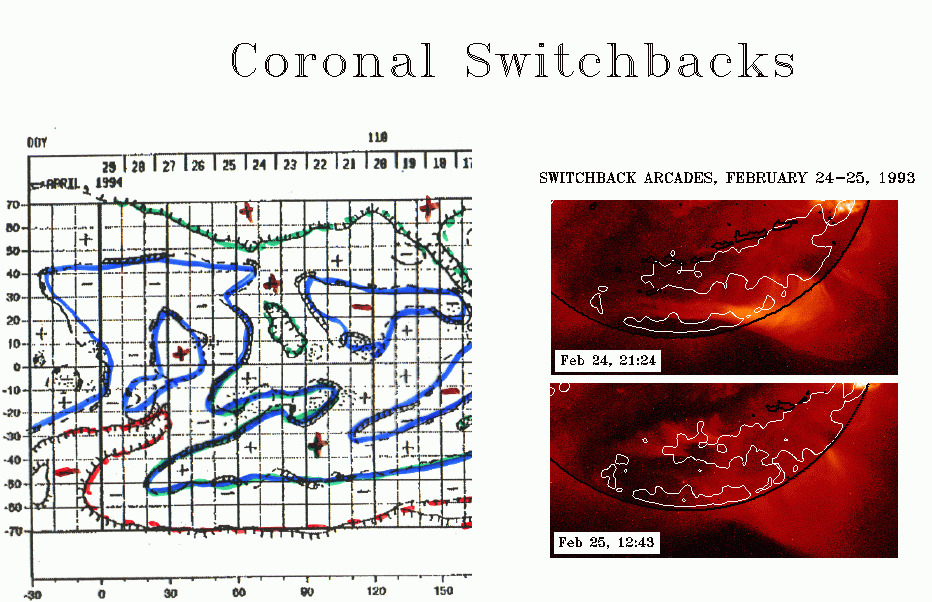
|
| Figure 5. The photospheric context and two related switchback CMEs on the main southern switchback in early 1993. See also Figures 6 and 7, below. The upper white dashed lines on the x-ray images indicate the inversion line shown in blue on the left. |
In the next cartoon we have reconstructed an east-west vertical cross-section through the switchback. We see how the closed arcade has moved in under the open fields from the coronal hole, as suggested above. The white light data was mapped at 1.36 Rs and 1.74 Rs. We have also used the Stanford Source Surface map at 3.5 Rs, and the McIntosh Ha map at 1 Rs.
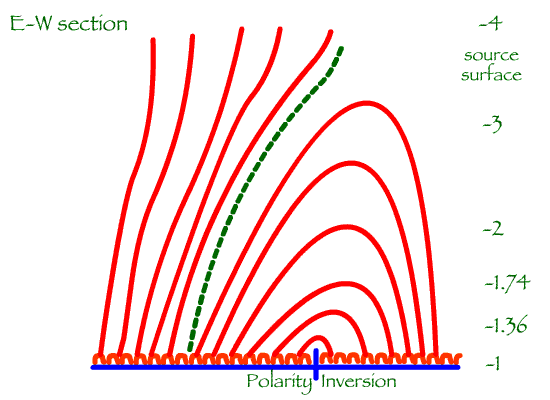
|
| Figure 6. Based on white light coronagraph maps for elevations, 1.36 Rs and 1.74 Rs, the Stanford source suface map at 3.5 Rs, and the photosperic map shown in Figure 5 above, we have constructed a vertical profile for the February 1993 switchback. This shows the extent to which the switchback arcade, rotating to the left has slid under the open coronal hole fields. The green dashed line is the sector boundary. |
Refer to Duncan's work.
That the clustering of CMEs along switchbacks is related to this dynamic between the rigid coronal hole extension and the drifting switchback arcade (being dragged by the inversion line), is supported by the mapping of several sequences during the early Yohkoh era. Below we show succesive rotations of this configuration, following the filling and closing of a coronal hole from October 1992 to March 1993. This is the same switchback modeled above.
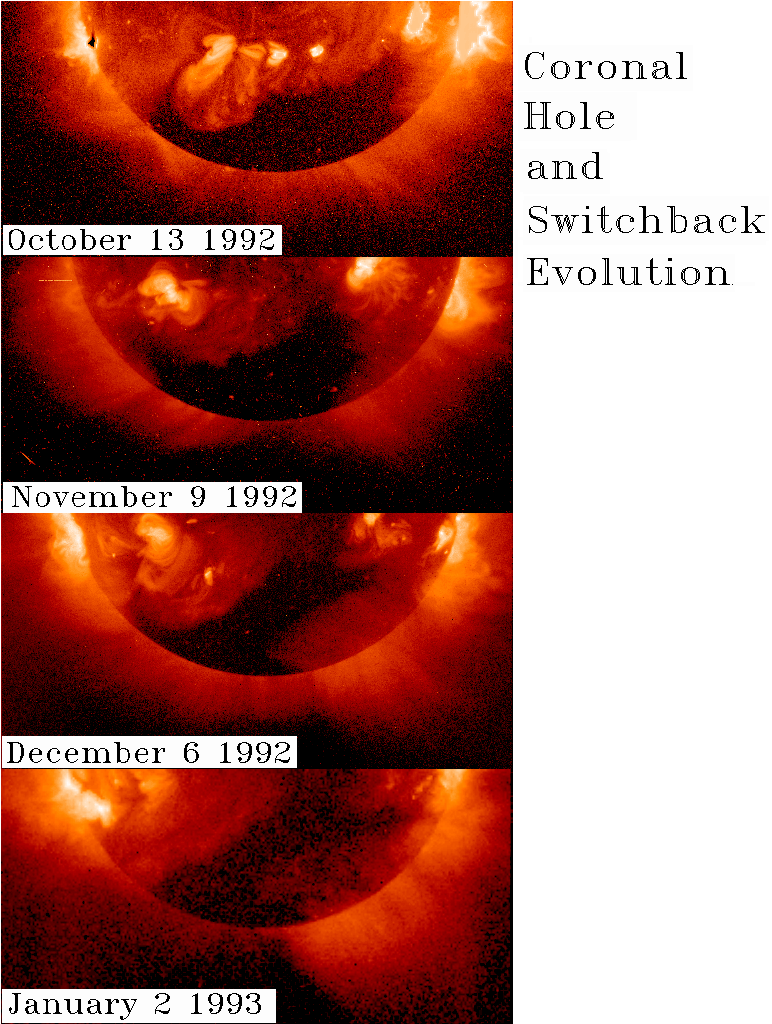
|
| Figure 7a. The main southern hemisphere switchback of late 1992 early 1993 drifting eastward (entering from the lower right) into a relatively rigid south polar coronal hole extension. See also Figure 5, above. |
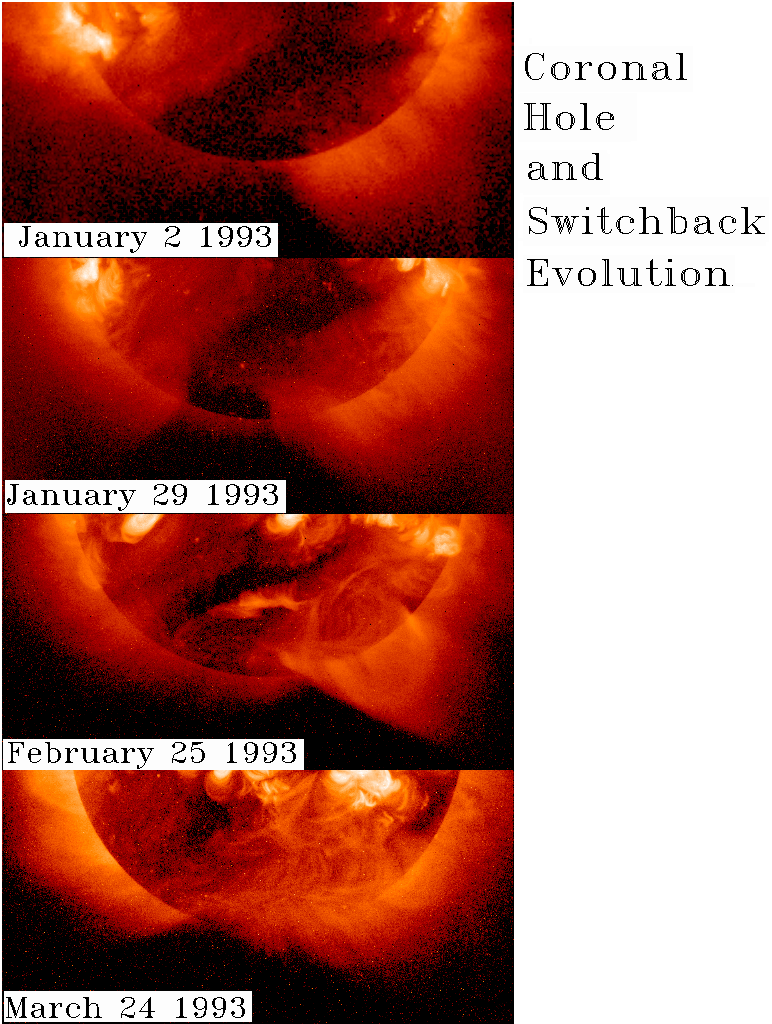
|
| Figure 7b. The switchback in the process of closing down the south polar coronal hole extension through a series of CMEs, several of which are visible in the last two frames. See also Figure 5, above. |
A year later a similar dynamic gave rise to the major cluster shown on the CME map shown in Figure 3 above. During the six months shown this switchback closed two seperate coronal holes. CHECK THIS!!!
Recurrance: From September 1993 to June 1994 there were 39 events around the main southern switchback, 3.9 per month. 7 out of 10 months from 3-5 events.The switchbacks drift eastward until the encroach on the coronal hole extension. There is then a period when they slow down as a series of CMEs help to reconfigure the open coronal hole fields. Eventually the extension closes, or is pinched off and the switchback drifts eastward again.
DISCUSSION & SUMMARY
We are not suggesting that the corona and photosphere are completely decoupled, however some slippage and decoupling is most likely a factor in coronal evolution.
It is also a key configuration for forecasters during the declining phase of the solar cycle. Both because of the repeated events, and because they are inherently located on sector boundaries, where the resultant CMEs can enhance geomagnetic activity [McAllister and Crooker, 1997].
The coronal hole boundaries are particularly rigid, as they slide easily. The arcades have to move more with the photoshperically defined inversion lines, and rotate at least partially differentially. [Check the speed for the period studied]
- Arcades are a good quiet sun proxy for CMEs.
- They occur preferentially and repeatedly in certain topologically defined locations, e.g. switchbacks.
- The rotation rates in the photosphere and the corona are often different, with significant consequences for coronal topology and evolution.
- The vertical shearing that appears to develop at switchbacks may be a major factor in their instability.
- It is important to study how these processes change with the solar cycle.
Notes
Most of this material is previously unpublished, or only briefly
published in short proceedings papers. While the main focus here is
to present the vertical shearing concept, it draws on several background
pieces and has implications for several more.
The research was completed largely between 1994 and 1998, while working
at HAO/NCAR and for Helio Research under various NASA and NSF grants.
REFERENCES
- Antonucci and Svalguard, 1974. differential rotation
- A. Bhatnager, Solar Mass Ejections and Coronal Holes, in Proceedings of IAU Colloquium No. 154, Pune India, in press Astrophys. Space Sci. 1996
- S. Bravo, A Solar Scenario for the Associated Occurence of Flares, Eruptive Prominences, Coronal Mass Ejections, Coronal Holes, and Interplanetary Shocks, Sol. Phys., 161, 57-65, 1995.
- Y. Hanaoka et al., Simultaneous Observations of a Prominence Eruption followed by a Coronal Arcade Formation in Radio, Soft X-ray and Ha, Publ. Astron. Soc. Japan, 46, 205-216, 1994.
- Hewish and S. Bravo, 1985
- E. Hiei, A.J. Hundhausen, and D.G. Sime, Reformation of a Coronal Helmet Streamer by Magnetic Reconnection after a Coronal Mass Ejection, Geophys. Rev. Lett., 20(24), 2785-2788,1993
- A.J. Hundhausen, The Size and Locations of Coronal Mass Ejections: SMM Observations from 1980 and 1981-1989, J. Geophys. Res., 98(A8), 13,177-13,200, 1993.
- D.H. MacKay, V. Gaizauskas, and A.A. van Ballegooijen, Astrophys. J. 544, 1122, 2000
- D.H. MacKay and A.A. Van Ballegooijen, Astrophys. J. 560, 445, 2001
- A.H. McAllister et. al., The Structure of the Coronal Soft X-ray Source Associated with the Dark Filament Disappearence of September 28, 1991 using the Yohkoh Soft X-ray Telescope, Publ. Astron. Soc. Japan, 44, L205-L210,1992
- A.H. McAllister et al., A Large Polar Crown Coronal Mass Ejection and a "Problem" Geomagnetic Storm: April 14-23, J. Geophys. Res., 101(A6), 13,497-13,515, 1996.
- A.H. McAllister and A.J. Hundhausen, The Relation of Yohkoh Coronal Arcade Events to Coronal Streamers and CMEs, in Solar Drivers of Interplanetary and Terrestrial Disturbances, ASP Conference Series, vol. 95, Astro. Soc. Pac., 171-179, 1996.
- A.H. McAllister and N. U. Crooker, Coronal Mass Ejections, Co-rotating Interactive Regions, and Geomagnetic Storms, in Coronal Mass Ejections: Causes and Consequences, eds. N. U. Crooker and J. Joselyn, Chapman AGU Geophysical Monograph Series, 279-289, 1997.
- A.H. McAllister, A.J. Hundhausen, D. MacKay, and E. Priest, The Skew of Polar Crown X-ray Arcades, New Perspectives on Solar Promiences, Proceedings of the 167 IAU Colloqium, eds. D. Webb, B. Schmieder, and D. Rust, 430-433, 1998.
- A.H. McAllister, D. MacKay, S.F. Martin, The Skew of High-latitude X-ray Arcades in the Declining Phase of Cycle 22, Solar Phys., 211, 155-163, 2002.
- P.S. McIntosh, Annotated Atlas of H-alpha Synoptic Charts for Solar Cycle 20: 1964-1974. Tech Rep. Upper Atmos. Geophys. Rep. 70. NOAA World Data Cent. A for Solar-Terr. Phys., Boulder Colo., 1979
- N.R. Shelley, et al., Coronal Changes Associated with a Disappearing Filament, Solar Phys., 45, 377-392, 1975
- Shibata et al., Observations of X-ray Jets with the Yohkoh Soft X-ray Telescope Publ. Ast. Soc. Jap. 44(5), 1992.
- Tomzack and Hassler, 1995?
- A.A. van Ballegooijen, N. P. Cartledge and E. R. Priest Magnetic Flux Transport and the Formation of Filament Channels on the Sun, Astrophys. J. 501, 866-881, 1998.
- A.A. van Ballegooijen, E.R. Priest, and D.H. MacKay, Astrophys. J. 539, 98, 2000.
- D.G. Webb and R.A. Howard, The Solar Cycle Variations of the Occurence Rate of Coronal Mass Ejections and the Solar Wind Mass Flux, J. Geophys. Res., 99, 4201, 1994
- Trace magnetic carpet
- Quiet sun flux emergence
- Assymetry of N-S coronal holes?
- S. Kahler, Solar Flares and Coronal Mass Ejections, Annu. Rev. Astron. Astrophys., 30, 113-141, 1992 LDEs??
- Low 1997, movement of photspheric flux northward?
Last amended January 6, 2004. © Alan McAllister. |